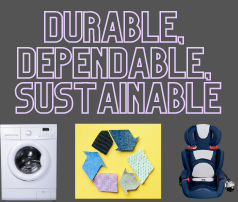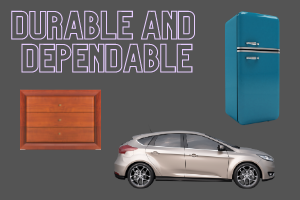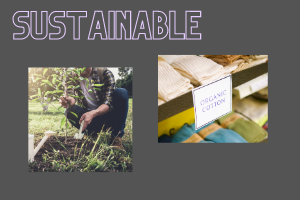 Green Benefits
Green Benefits
Durable, Dependable, Sustainable

Here at Chicago Textile Recycling, we educate and spread awareness to our readers about the importance of recycling, and more specifically the importance of textile recycling. We also want our readers to know about buying sustainably and responsibly, choosing companies that are environmentally responsible in how they make clothing and other products. Fast fashion promotes overproduction of clothing that isn’t necessarily made of materials that will last, and we want our readers to be mindful of what they buy, thinking more of longevity and sustainability in what they choose to purchase, helping to care for the health of our planet.
In his book, “Secondhand: Travels in the New Global Garage Sale,” Adam Minter discusses the importance of making durable products and potentially creating some kind of regulations to hold companies accountable to making quality products that will last. Whether through government standards and laws or a more simpler approach of company transparency, he educates his readers about change to current production that would help buyers have a more informed approach to making decisions about their purchases.
Durable and Dependable

“As products pass from first owners to second and third, that value is passed along.” (Minter, p 213)
Long ago were the days when you could buy a product and count on it lasting for decades, or sometimes even long enough for it to be a generational heirloom. Or so it seemed. In his book, Minter relays a trip he took to Speed Queen washing machines, a company committed to making a product that would last thirty years or more. Their main customers are those who have already owned multiple washers which have all failed the test of time and repeated use.
In response to this need, Speed Queen created a washing machine that would be durable and dependable for years to come.
“Speed Queen isn’t the only company to realize that there’s money to be made by reembracing dependability, and the home appliance sector isn’t the only consumer sector in which a company seeks to differentiate itself on the basis of product lifespan.” (Minter, p 212)
Many products in existence don’t have standards holding the companies accountable to the quality of the product they are selling. Minter addresses this,
“So what more can be done? One option is for governments to become more directly involved in regulating the durability of products. To some extent, they already are. Minimum safety standards in cars, child safety seats, electrical appliances, and other products are common and necessary.” (p 214)
However, Minter doesn’t see this as a one answer fits all type of solution. He continues,
“The better approach is simpler: companies must be transparent about the lifespans of their products and attach a sticker or tag (physical in stores, and virtual for online) to their products informing consumers of just how long they’re projected to last, based on verifiable testing. The requirement doesn’t necessarily have to be a government regulation in order to have an impact. A voluntary program in which industries agree on durability standards and how to label durability would work just as well (and perhaps even better).” (p 214)
This requirement would make sense for products that would have years long lifespans, such as cars and appliances, etc, but what about things like shoes and textiles and well-made toys? Minter addresses this as well:
“Of course, there are many ways to measure lifespan. For some product categories, like washing machines and other home appliances, timeframes can be measured in years. For apparel, it might be a grading system that takes into account a range of factors, including colorfastness, resistance to abrasion, and durability in a home washer (these standards mostly exist, by the way). For more complex products, like laptops, fairness might dictate that manufacturers reveal the expected lifespans of replaceable parts, starting with batteries. For smartphones and other short-lasting consumer electronics products, the timeframe should incorporate the months or years that the manufacturer plans to support the product with security and other software updates.” (p 214-215)
In further discussing this rethink, Minter states:
“Child safety seats are an excellent example of how transformative this rethink might be. At the moment, seat manufacturers have no incentive (or regulation) requiring them to reveal or compete on the durability of their products. And so long as parents can’t evaluate a seat in terms of how long it will last, manufacturers can get away with suggesting that the devices are, effectively, hazardous on expiration. Lifespan labels would eliminate that practice by forcing manufacturers to compete over lifespan—and build accordingly. Logically, the seat advertised to last ten years will outsell the one advertised to last six.” (p 215-216)
This problem is one my husband and I came across when we decided to purchase a credenza style cabinet for our living room to help declutter the room. After reading Minter’s book and seeing some of our previous less expensive purchases wear down quickly over time and use due to how they were made, we decided it was important to us to invest a bit more money and buy a quality product made of solid wood that would last through the years and potentially have resale value down the road or even be something that could be passed down.
Over a month of searching for this item, we finally came across a secondhand credenza that worked for our space and aesthetic. This was a solid wood piece of furniture the seller had had built by a friend for their home. It was exactly the kind of quality we had been searching for and buying it secondhand saved us hundreds and hundreds of dollars.
Sustainable

Durability and dependability are important factors to look for when purchasing items, but sustainability is equally important and one that works hand in hand with the other two.
“Encouraging consumers to think more seriously about the financial, environmental, and personal costs of their consumption would be a major step in addressing the crisis of quality and the environmental and social impacts of too much stuff. Better yet, it would spur businesses to seek economic incentives to design and market better products. Today’s secondhand economy, faltering in search of quality, should have more than it can handle.” (p216)
Making a secondhand purchase is making a sustainable purchase. Merriam-Webster defines “sustainable” as “of, relating to, or being a method of harvesting or using a resource so that the resource is not depleted or permanently damaged.” Buying things that are well made from quality resources is buying sustainably. Choosing companies that create products from recycled materials is buying sustainably. Making the decision to buy sustainably comes at a cost, a higher cost than less well made products, but is well worth it as the product will typically outlast less well-made products, and peace of mind in knowing it has less of a detrimental impact on our planet.
For the textile industry, this means choosing to purchase clothing secondhand or from companies touted for using organic or recycled materials. Or choosing those that are committed to making quality items guaranteed to last.
CTR and Wipeco, Inc

As noted previously in our blog about wipers, the quality of recycled textiles over the years has deteriorated. This has mainly come as a result of fast fashion and the standards of clothing plummeting to cut costs for clothing companies. With clothing and textiles wearing out faster due to being cheaply made, we have received textiles of poorer and poorer quality accordingly here at CTR.
For our parent company, Wipeco, Inc. and other wiping rag suppliers, this is a problem. As our customers continue to desire well made rags of 100% cotton, but the donations we receive are mainly mixed fabric of low quality, we have to source from other places to purchase the textiles and rags our buyers want. This goes hand in hand with Minter’s book.
Clothing and textiles that are poorly made reach their end of life faster, which means adding more to the landfill and greenhouse emissions. These textiles also have no use in circular fashion thus far. They are likely too poor of quality to be reused for very long, or to be used as wipers by most customers. Potentially they are not viable as fiber content or being broken down to threads to be rewoven as new textiles either.
The answer is simple, and it is to care about quality once again. To bring back the days of purchasing clothing that is well made because you know it will last. And this applies not only to clothing, but to all purchases our readers make. Let’s commit to investing more in products that will stand the test of time and use. Let’s commit to products and textiles that are durable, dependable and sustainable.